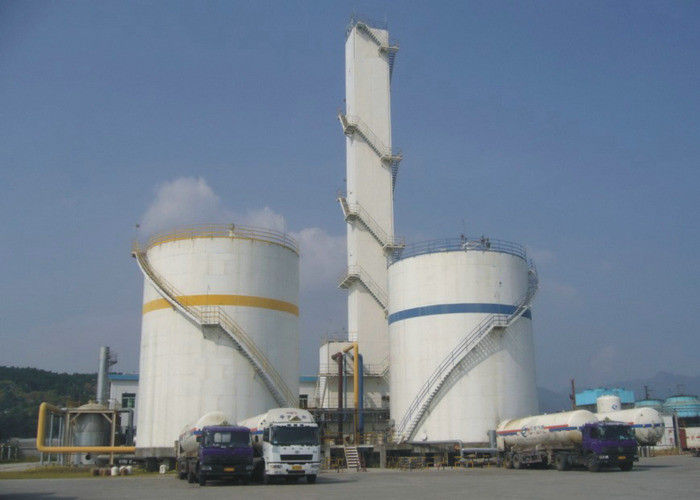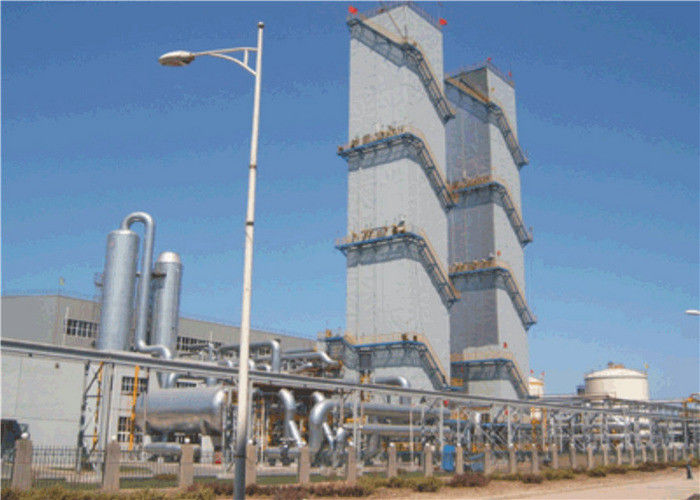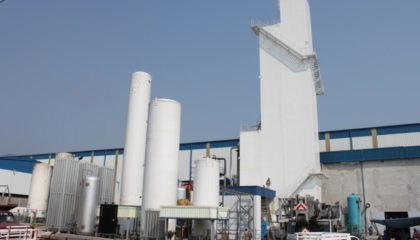December 19 2017
The Importance of Soil Management
A nitrogen plant offers liquid nitrogen plant a very important function as it makes a product which crops will need to have the ability to flourish. All living things rely on the maturation of plants and trees to have the ability to thrive. All of this often goes on behind the scenes, and most of us take it for granted. Thankfully, there are pros in area that take care of all of this so we don't need to fret about doing it air separation plant process flow diagram.
A nitrogen plant can assist with powerful soil administration. When the soil has what it requires, crops, plants, and other household items are able to flourish. There may be many factors with the growth of these elements. However starting them out with the right balance in the soil can increase the chances of an excellent outcome.
The Proper System
With a nitrogen plant on website for your industrial organization, you can create what you will need to care for your business requirements. It doesn't need to be a intricate endeavour to get it all set up. With the ideal supplier, you can learn about the alternatives for generators. You may get the capacity that'll work for your needs. Not only now, but looking at the forecasted growth in the foreseeable future.
The perfect system will meet or exceed your requirements in terms of circulation, pressure, and quality. Depending on the sort of business you are in, there might be specifications relating to the purity of this product created at the nitrogen plant. You should continually be within those guidelines or you can get into legal trouble.
Customized for Your Demands
Should youn't have a nitrogen plant in place, this may be the perfect time for you to think about having one built. They may be created to your specifications such as the dimensions and the location. The output you need can affect what you approve. Talking to a professional in this realm will be able to enable you to evaluate the options. You can consider the pros and cons of each to make a choice.

That is a wise investment since it might allow you to have better production. It can decrease the risks of merchandise not growing as they need to. It can decrease the risk of depleting the soil of nutrients it'll struggle to naturally add back by itself. The delicate balance that has to be set up can not be overlooked or taken for granted.
Tech and Upgrades
An elderly nitrogen plant can gain from various upgrades over time also. Technology changes and new approaches are made to make it more efficient. If the plant is behind the times, it is not as effective as it might be. It is not offering the identical general worth as the newer ones. It may be expensive and time consuming to create those updates but it is a wise alternative.
There are many benefits with this sort of set up, and it can save you both time and money. With a plant on web site, you don't have to pay to have nitrogen caused on a regular basis. You might also have more control over the purity it offers. This is a good way to be more efficient and also to improve your results. Consider your business goes and think about an investment.
It might allow you to be a leader in your business. It could build your reputation so you are well known as a solid firm. That will encourage one to acquire more clients and it'll also enable you to make a base you can continually build upon.
Air separation plants could be installed easily and does not require any particular buildings and entails a brief erection time. Power price is your main operating cost involved with air separation plants and might account for nearly two thirds of their total operating costs. Electric motors are used in running the motor and at the heating and cooling procedures.
Different Kinds of Air Separation Processes are used for various applications. Cryogenic separation is based on differences in boiling points of the several gases found in air. Non-cryogenic plants are much less energy efficient than cryogenic plants and are more suited to small and medium plants.
Cryogenic air separation processes rely on differences in boiling points to separate and purify products. The basic procedure was commercialized early in the 20th century. Since that time, numerous process configuration variations have emerged, driven by the desire to create particular gasoline products and product mixes as economically as possible at various required levels of purity and pressure. These procedure cycles have evolved in parallel with improvements in compression machinery, he
The cryogenic air separation plant involves a refrigeration cycle in which the gases are cooled to a very low distillation temperature. Only pure gases may be utilized in cryogenic distillation as water and carbon dioxide of air can freeze from the cryogenic equipment. For bulk manufacturing, cryogenic processes would be the most cost-effective choice and these could produce very pure end products.
PSA Nitrogen plants are called so as these Nitrogen Generators operate on Pressure Saving Adsorption commonly known as PSA Technology. The nitrogen I gasoline is separated from atmospheric air by using carbon molecular service which removes oxygen from atmosphere. The compressed air is first passed through the adsorption tower where water oxygen and other gases are adsorbed, leaving behind nitrogen, which is then collected in a surge vessel. This procedure is efficiently used to make ultra pure Nitrogen gas of 99.9999% purity for commercial purposes. High purity is guaranteed by utilizing De-Oxo purification. This system is used in various applications such as pharmaceuticals, cold rolling, steel industry, metallurgy, fertilizers and electronics rectifier industry.
B2B markets are fantastic place to collect information about the latest kinds of air separation plants and the many buyers and sellers of this item. These online hubs can even keep you well informed regarding events and sidewalks also.
Heat exchangers are common elements of several devices and machines employed in many industries today. Heavy industries like petroleum gasoline plants, power plants, sewage treatment facilities and oil refineries use them in their equipments. The machines used in such businesses not only require constant tune up, they also require constant cooling. Heat exchangers perform this task for them.
Definition nitrogen plant cycle
Heat exchangers are devices that are installed to facilitate efficient heat transfers from 1 medium to another. These mediums are usually in the kind of water and other liquids. The method involves AirSeparationPlant liquids being separated by a thin solid wall which can keep it from being in direct contact with each other. There are also heat exchangers that let these liquids mix during the transfer process.

Different kinds
There are lots of kinds of heat exchangers. In addition to the tube and shell, here are just Air Separation Plant liquid nitrogen three more Kinds of frequent exchangers typically used in most of today's apparatus:
· Plate Heat
These kinds has many plates that are generally thin and slightly split when put in the machines. They are usually large in surface area which enables it to process heat transfers nitrogen producing plants involving mediums readily. When compared with the shell and tube, the plate heat exchanger is said to be more effective because it includes a stacked-plate arrangement.
Over time, many machines have transformed to such kind due to its practicality and efficacy of use. In machines like a fridge, these can either be one of two kinds: dip-brazed or even vacuum-brazed.
These devices can also be classified based on the types of plates that they use. They can also be discerned by the configurations of the plate being used. Some plates may have their own special designs with different stamps, patterns, springs or fins.

· Plate Fin
A plate fin uses pairs of passages, commonly referred to as sandwich passages, which increase the efficiency of the whole machine. Various fin configurations is comprised in a plate fin heat exchanger. These include directly fins, wavy fins and counter fins. The design of this specific exchanger also includes some cross flow and counter flow layouts.

The greater heat transfer efficiency exhibited by means of a plate fin exchanger can be credited into the aluminum metal which it is constructed from. This particular mixture enables the plate fin to work in a much lower temperature all while reducing the burden of the equipment it was installed to.
This kind can be generally found on machines which are utilized for the processes of natural gas plants, liquefaction plants, air separation plants and a lot more. It can also be found inside engine engines.
· Adiabatic Wheel
This sort of heat exchanger makes use of intermediate fluid and strong during its heat transport procedures. Adiabatic wheels include a huge wheel together with really fine threads which rotate throughout the hot and cold mediums. This enables the efficient heat transfer between the two fluids.
Nitrogen Gas Plants are available in small, medium and big capacity. Widely used in Water Process, Ferrous Metallurgy, Non-ferrous Metal Refinery, Coal mines and Pharmacy, these can be availed at industry leading prices. N2 gas plants are incorporated with exceptional engineering and faultless quality. Highest standards of quality of goods & services are provided to fulfill client's expectations by using the latest technologies and the highest quality components.
Nitrogen Gas Plant are famous for discover this info here the following attributes:
Skid Mounted Version
Low Stress Technology
Low Power Consumption
24 Hrs Continuous Air Separation Plant oxygen manufacturer Duty Operation
Only One Operator Required To Run The Plant
Heavy Duty Air Compressor (Water Cooled.)
Built In Liquid Oxygen/Nitrogen Pump For High Pressure Oxygen/Nitrogen Filling
Built In Integral Gas Vaporizer
High Efficiency Trays for High Purity
Unbelievably Safe http://www.airseparation-plant.cn/ To Use And Run
Trouble Free Operation Because Of Proven Design and Performance.
PSA Nitrogen Plants:
PSA normally means "Pressure swing Adsorption Procedure", so PSA Gas Plants are the read this plants or equipment supplying nitrogen gas at an outlet at purity of 99.99%.

Nitrogen Plants integrates qualified engineers for Supervision, Installation and start up of all our plants as well as training of work at client's site. The different type of PSA nitrogen system are supplied by varied ranges.
Dealing in premium quality Nitrogen Generators, world-class Air Separation Plant Social Network nitrogen gas generator operates on PSA technology.
Salient Features of PSA N2 Gas Air Separation Plant nitrogen Plants are as follows:
Skid mounted components
Easy installments
Safe & Economical
Assures purity
Maintenance free Click Here for Wikipedia of price
Continuous supply.
There are different kinds of gases that are categorised as majority gases, and all these are: Argon, Carbon Dioxide, Hydrogen, Helium, Oxygen, Nitrogen, Nitrous Oxide, Propane and Propylene.
Bulk Carbon cryogenic air separation Dioxide
Source: Fermentation in distilleries and breweries are the most important source of carbon dioxide, and it will be pure.
Generation: Artificial carbon dioxide is purified in many phases, it is compressed and cooled to obtain liquid carbon dioxide at a pressure of 20bg (pub gauge) and at a temperature of 20 degrees, it is collected and stored in massive tanks; if the tanks are complete they are isolated and made available for supply.
Quality: Bulk Liquefied carbon dioxide, and this can be supplied to the food and beverage Air Separation Plant liquid oxygen industries, has the most stringent and detailed product specifications.
Gaseous possessions: Colourless, tasteless and odourless. nitrogen plant working principle Inert when the gas is dry. Highly soluble in water.
Liquid properties: At atmospheric pressure, it can't exist. It will become super crucial when it's heated and pumped above its critical point.
Volume liquid Nitrogen
Nitrogen (N2) is the major gas in our air; which makes up about 78% of it. The commercially available N2 is made from larger 'cryogenic air separation plants' and within this kind of plant atmospheric atmosphere is totally washed and the gas is compressed and later it's cooled by expansion to create the liquid gas. This liquid gasoline is transported or stored at a temperature ranging from -196 to155 degrees Celsius.
Gaseous possessions: Colourless, tasteless and odourless. Non-flammable at quite high temperatures. Slightly soluble in water.
Liquid properties: When it vaporizes, it consumes a lot of heat. Has very higher heat transfer rate.
Bulk Liquid oxygen
Oxygen (O2) is one of the critical gases the air, and it comprises approximately 21% of atmosphere. The commercially accessible O2 is made from larger 'cryogenic air separation plants' and within this kind of plant, atmospheric air is completely cleaned and the gas is compressed and after it is cooled by expansion to make the liquid gas, and will be separated by fractional distillation. This liquid gas is transported or stored at a temperature ranging from -183 to 143 degrees Celsius.

Gaseous properties: Colourless, tasteless and odourless. Non flammable, but encourages and enhances combustion of other substances.
Liquid possessions: Blue in colour.
Bulk Liquid Argon
This gas comprises just 1% of the planet's atmosphere. The commercially available argon is made from bigger 'cryogenic air separation plants' and in this type of plant atmospheric air is totally cleaned and the gas is pressurized and later it is cooled by expansion to make the liquid gas and will be separated by fractional distillations. Industrial established argon contains slight amounts of oxygen, and if pure argon is wanted, the gas requires more purification and distillation. Liquefied argon must be stored at temperatures ranging from - 186 to - 143 º C and also the pressure requirement ought to be approximately 20bar. Normally this liquid argon must be transported at low strain.
Gaseous properties: Colourless, tasteless and odourless. Soluble just in water. Non flammable. Extremely inert.